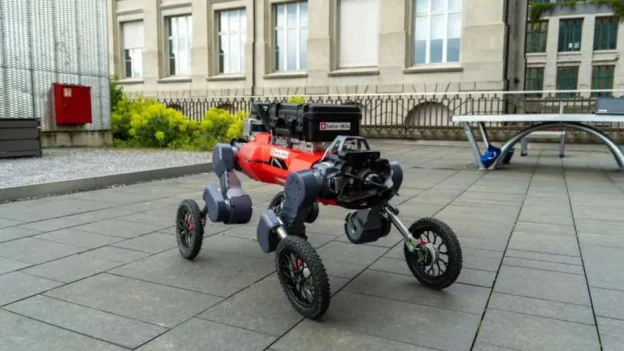Researchers at ETH Zurich’s Robotic Systems Laboratory have developed a robot that combines wheeled and legged mobilization. This device, described in an article in Science Robotics, is capable of navigating diverse environments using reinforcement learning techniques. reinforcement learning allowing it to switch fluidly between driving and walking modes depending on the terrain.
This development is the fruit of more than five years dedicated to research in legged robotics, autonomous navigation and perception.
explained Joonho Lee, co-author of the study, in an interview with Tech Xplore.
The robot is based on an earlier design by the CERBERUS team, known for its win in the DARPA Subterranean Challenge 2021 . However, this new model features a simplified design and an artificial intelligence-powered navigation system.
Reinforcement learning technology
To achieve autonomous navigation, the researchers developed and trained several hierarchical reinforcement learning techniques. They then created a controller based on neural networks capable of processing various types of data, allowing the robot to generate new navigation plans in a matter of milliseconds.
On smooth surfaces, the robot uses its wheels to move efficiently and conserve energy. However, when faced with difficult terrain, such as steps, it switches to walking mode. This hybrid approach allows you to combine the strengths of wheeled robots with the capabilities of legged robots.
The advanced neural controller developed by Lee’s team can interpret sensory data to determine the most efficient way to move in different terrains. This gives the robot the ability to overcome high obstacles and navigate for longer periods than conventional robots.
Unlike traditional planning and control methods, which often fail in real environments due to uncertainties and disturbances, the team’s controller uses two artificial neural networks to process sensory data and coordinate the robot’s movements. It also includes basic terrain mapping and SLAM (simultaneous localization and mapping) modules.
The robot was put to the test
The navigation system was tested in several experiments in real environments, proving to be very reactive and efficient. The robot managed to travel more than 10 km through Zurich and Seville, demonstrating its ability to perform in various European cities.
In the future, this leg-wheeled robot and its navigation system could be perfected and implemented in a variety of environments. One of the most promising applications is the autonomous and fast delivery of goods in different types of terrain.
Follow us on social networks and don’t miss any of our publications!
YouTube LinkedIn Facebook Instagram X
Source and photo: techxplore

